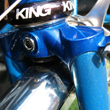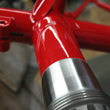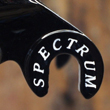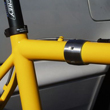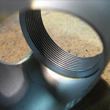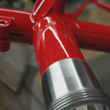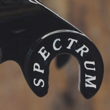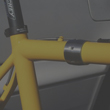
Materials | Titanium | Steel
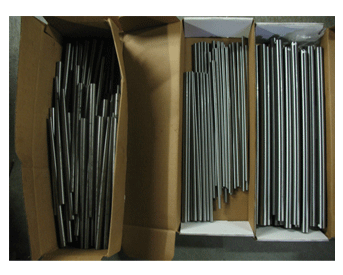 There are basically four bicycle materials on the market today. Steel has been around forever and has a unique and classic feel. Similarly, aluminum bicycles have been tried and tested and are renowned for their stiffness and light weight. Somewhat newer to the game is Titanium and it's here to stay. Finally there is Carbon Fiber. Composites (or carbon fiber) can be light and stiff at the same time. So how can you choose which one is right for you? Perhaps this will help. There are basically four bicycle materials on the market today. Steel has been around forever and has a unique and classic feel. Similarly, aluminum bicycles have been tried and tested and are renowned for their stiffness and light weight. Somewhat newer to the game is Titanium and it's here to stay. Finally there is Carbon Fiber. Composites (or carbon fiber) can be light and stiff at the same time. So how can you choose which one is right for you? Perhaps this will help.
STEEL
Steel, the original racers choice offers a predictable ride. In general, a well made steel frame can be responsive and stiff. A well made steel frame can last years but over time and kilometers it will fatigue and rust. When it comes to a custom bicycle, steel enables experienced builders like Jeff Duser and myself at Spectrum, Richard Sachs and others to really dial in the ride characteristics of the frame. We also think lugged steel frames are the most beautiful of all.
ALUMINUM
Aluminum offers a very stiff (often harsh) ride. Lighter than a typical steel frame, aluminum can offer quick handling and excellent transmission of your energy to the road. It does fatigue over time and is far to jarring a ride for many riders. It's relatively inexpensive and thus popular.
TITANIUM
Titanium happens to be one of my favorite materials to ride. It's light, won't rust or fatigue, and designed and built properly offers an amazing combination of stiffness and comfort. Ride a Spectrum Titanium and you will know what I mean.
CARBON-FIBER
Carbon Fiber is light and strong. In the hands of the right manufacturers, this material makes a great fork. In fact, Spectrum recommends carbon-fiber forks on most of our Titanium bicycles. When it comes to a complete frame however, Carbon fiber just doesn't feel as lively as steel or titanium. Ride a full carbon frame at your local bike shop and you'll see what I mean.
Return to Top
TITANIUM RESPONSIVENESS
By 1987 (the year I tested the first prototype Titanium frame) I had already built dozens of bikes for my own personal use. Given my training and racing style I had come to what I thought was my ideal frame design. My personal steel frames were built with a 55cm ctr. to top seat tube, a 58 top tube, 73-degree seat angle, 73.5-degree head angle, and a 7cm drop. In working with Merlin on that first Titanium prototype, it seemed logical that I simply build my ideal steel frame only this time in Titanium. I wanted to compare steel and Titanium with a minimum of confusing variables. At the time, I thought the Titanium prototype would ride similarly to my steel frame since the design of the two frames was identical. Boy was I in for a shock.
After only a few seconds on the Titanium bicycle I swore I must have completely redesigned the frame. It seemed to fit the same. I measured it and it had the same wheelbase. The clearances of my steel and the Titanium prototype were also the same. One thing was quite different though. The titanium bike felt considerably quicker handling. Handling responsiveness seemed to be instantaneous on the Ti prototype compared to my trusty steel frame. I still remember how alive that first ride was. In fact, all my rides on Spectrum Titanium bicycles feel as alive as the first.
I soon found out that the handling advances of a well-made Ti frame do not hold for all Ti frames. Only high quality Titanium frames built by knowledgeable and experienced masters are able to enable Titanium to feel so lively. Several factors can lead to a less than ideal titanium feel. For example, Titanium tubes tends to loose the "Ti advantage" when tubes are tapered or use thicker gauge tubing because of smaller diameters. The noticeable handling changes appear to be related to the resiliency of the entire structure. Put simply, Titanium is a very resilient material. If that resiliency isn't designed out of the frame, handling responsiveness is enhanced. The advantage is that a builder with the knowledge and experience can design an even more comfortable and stable Titanium frame while at the same time improving responsiveness.
If you think this is a bit confusing, get out there and ride a Merlin or Spectrum. After looking at the specs, you will see what I mean.
TITANIUM ALLOY
Bicycle frames made of Titanium are actually made of a titanium alloy. The two most common titanium alloys used in the cycling industry are 6/4 and 3/2.5. The numerator in each fraction refers to the percentage of aluminum and the denominator refers to the percentage of vanadium in the alloy. These two different alloys are both high strength titanium and are both fairly common in the industry. 3/2.5 titanium alloy is by far the most commonly used for tubing in titanium frames while the 6/4 alloy is actually the stronger of the two.
Many people assume that since 6/4 titanium alloy is stronger, all Titanium frames should use it, but it is not that simple. Because 6/4 is stronger than 3/2.5, the mills who draw titanium tubing have a very difficult time working the 6/4 alloy. In addition, strength of these alloys is not the issue that many people think it is. Quite simply, the high quality 3/2.5 bicycle frames on the market simply do not break. Therefore, making a frame from 6/4 alloy simply for increased strength doesn't make sense (it just costs more money). Please note that there are 6/4 frames on the market but most of them have seamed 6/4 tubing. The fact that their 6/4 tubing is seamed is very significant. There are three problems with seamed 6-4 titanium. First, in order to make 6-4 plate into tubing it needs to be annealed, lowering the strength by about 20%. Second, the grain structure of the plate, when rolled into the tube shape is altered and no longer appropriate for optimal alloy strength. Indeed, it lowers the tube's strength considerably. Third, the weld area that runs down the length of the tube has a completely different grain structure from the rest of the tube and has surface irregularities that lower the fatigue strength of the tube. While these tubes can have well finished external welds, the inside surface of the welds are not finished and the grain structure and surface irregularities present inside the tubes create stress risers that can lead to premature failure.
In addition to the strength of the alloys, the modulus (or measurement of stiffness) is also important. 6/4 and 3/2.5 have effectively the same modulus of elasticity. In simple terms, the two alloys have the same effective stiffness. This in turn means that the ride between frames made out of the two alloys will be the same assuming all other frame specifications are the same.
The Spectrum Super are made out of double butted 3/2.5 custom drawn tubing from Haines International. The tubing specifications Spectrum uses are the most stringent in the industry (in any industry come to think of it). Even the tubing shipped to Boeing for their passenger jets are not manufactured to as tight tolerances as Spectrum's. You can actually see some of the result by looking at the surface finish on a Spectrum and comparing it to other manufacturer's frames.
When talking about metals, in this case titanium alloys, there are some basic considerations to be discussed. Tensile strength, yield strength, modulus of elasticity, and notch hardness are all characteristics of metal alloys that effect real world performance.
Tensile strength refers to the greatest longitudinal stress a substance can bear without tearing apart. While this can be a factor in the overall strength of a metal alloy, in a bicycle, it's not the only factor. This is due to the fact that bicycle frames rarely fail by being pulled apart. They fail from either yielding (bending) or from fatigue. Tensile strength alone does not directly quantify how a frame will hold up to these types of failure. In fact, tensile strength (above a certain point) is essentially irrelevant to the strength of a bicycle frame. As long the tensile strength is high enough to resist all TENSILE failures, that is enough.
Yield strength is also a contributing factor in the overall strength of a frame. Yield strength comes into play as tubing walls gets thinner and tube diameters increase. Thinner tubing tends to buckle or "beer can" more easily. Higher yield strength will help the tubing resist this kind of stress and thus resist "beer can" failure. Because lighter steel and titanium frames do have larger diameter tubing and thinner tubing walls, there can be yield problems especially in head-on crashes. Some tubing is so thin even simple handlebar hits can cause ripples and dents that could lead to failure. Thankfully, larger diameter thin-wall titanium tubing is still much tougher than the ELOS type steel tubing on the market by an average of about 75%. i.e.. it takes about a 75% increase in force to do the same thing to a Spectrum Super than it does to an ELOS type steel frame and you can chalk that strength up to the amazing yield strength of titanium.
Another factor to consider is the modulus (or stiffness) of titanium. Though a fairly technical concept, I'll do my best to explain it. In measuring modulus of a titanium tube, one has to measure it in both bending and torsion to fully evaluate it. Of the two titanium alloys used in bicycle tubing, 6-4 and 3-2.5, the 6-4 is clearly stronger over-all. However, top shelf 3-2.5 and 6-4 tubes compare in some interesting ways.
Although 6-4 sounds great at a glance (and indeed is pretty neat stuff) it is not necessarily better than other titanium alloys in all situations. As expected the stronger 6-4 tubing has a slightly higher modulus in bending compared to the 3-2.5 tubing. However, the 3-2.5 alloy has a higher modulus in torsion. Moreover, if you average the two modulus strengths of the alloys, you end up with a surprisingly even match. Its seems then that to build the most rigid frame with the lowest weight, a builder should use a mixture of both 6-4 and 3-2.5. Of course there is more to it than that though. One must not forget notch hardness.
Now to notch hardness or fatigue strength. Notch hardness refers to a way of quantifying how well the crystal structure of an alloy will hold together under repeated cyclical stresses. This is where 3-2.5 alloy starts to really make sense when compared to the seemingly better 6-4 stuff. Not only does 6-4 have a lower notch hardness than 3-2.5, but the way most 6-4 tubing is manufactured causes additional negative outcomes related to tube strength. The seamless 6-4 titanium tubing on the market is quite well made and finished. It still has the notch hardness problems that all 6-4 has, but its seamless manufacturing eliminates some of problems of seamed 6-4 tubing. Currently, seamless 6-4 tubing is available in very few diameters and gauges, again reducing its usefulness.
Please note that steel tubing, unlike 6-4 titanium tubing, can be rolled and seamed without the same weaknesses. That is because steel tubing can be drawn to smooth the weld, then annealed and heat treated to recover its strength. 6-4 cannot be processed the same way. If you were to heat treat it the way steel is heat-treated, it would make it too brittle for use. If you were to anneal titanium, strength would decrease and for practical purposes, it cannot be cold worked enough to make any significant difference.
If any of that seems too technical, give me a call. I love talking about metal!
In short, I'll say this, 6-4 titanium alloy has no advantage (other than for marketing) over 3-2.5 alloy when it comes to bicycle tubing applications.
Return to Top
WHY WE STILL USE LUGS
Our steel frames are lugged for two reasons. Lugs are stronger and lugs are beautiful. Did we mention that Lugs are stronger? Almost all mass-production steel frames produced today utilize cost-effective tig welding to join tubes. This prompts a question: why do we still use silver soldered lugged joining? There are two basic answers. First, properly fitted and soldered lugged joints are considerably stronger than joints created any other way. Second, they give us and other traditional builders a way of showing off. We can demonstrate, not only our soldering skill, but also how we believe a frame's details should appear.
ON STRENGTH
In the late '80s, a team of scientists in the UC Davis engineering department undertook an in-depth look at the relative strengths of various steel joining techniques at the request of "Bicycle Guide" magazine. The three top frame builders associated with the three primary joining techniques were asked to supply joining samples using tubing supplied to the builders from the same mill run. Tom Ritchie provided the fillet-brazed samples, tig-welding was done by Gary Helfrich, and the silver soldered lugged samples were done by Spectrum's Jeff Duser. The samples were fatigue tested, in some cases to failure. In most cases, the joints did not fail. More often, the tubes failed at or near the joint. The team's study involved microscopic analysis of the crystal structure of joining zones, heat effected zones and failure sites. They concluded that all three joining techniques, done properly, are clearly of sufficient strength for the purpose of bicycle frame construction. The different results obtained from the samples resulted primarily in the heat-affected areas of the tubes themselves. Not surprisingly, the tubes that were soldered turned out to be stronger than the tubes that were welded or brazed. So, what does this mean in the real world? Frames built with silver soldered lugs will last longer than those that are fillet brazed and considerably longer than those that are welded. However, for most of our customers, the real practical difference is that lugged frames hold up in crashes better, and when it becomes necessary, they are much easier to repair.
ON MODERN AIR HARDENING TUNING
The latest generation of air-hardening steel tubing used by top quality welding frame builders was not available at the time of the UC Davis study. We at Spectrum expect that this tubing, when in the hands of master builders, is more reliable than the welded joints and tubes tested at UC Davis but still less strong than lugged joints.
ON BEAUTY
All high-end lugged frames today use investment cast lugs and bottom bracket shells. For practical purposes, the lugs are all of equal quality. Most American frame builders use Henry James cast components because of their availability in a variety of sizes and angles. With so many builders using the same lugs, how much difference can there be between the various builders' lug work? As it turns out, the differences are substantial. Depending on how much time a builder is willing to spend on their lugs, the appearance and strength of the final product using the same frame components can vary a great deal. We typically spend hours on our lugs, finishing them as preparation for building your custom steel frames. However, the design of the UC Davis metal joining study did not allow us to finish our lug-work. Because of this, the joints tested in the study, though clearly stronger than welded joints, were not as strong as the ones used in our production frames.
WE MAKE OUR OWN LUGS FROM SCRATCH
Talk about taking too much time! We actually make, from scratch, all the lugs that are required to
construct our steel frames. Is this an efficient method of construction? No way. Is it a better and more
beautiful method of building a custom frame? Absolutely. It's all we need to know.
We've been making our own lugs for a number of years now for a few reasons. First, creating lugs
specifically for the design of your custom frame allows us to design the frame perfectly for you without the
constraints that pre-cast lugs exert on the builder. This way, we can use any angles and tube diameters,
any head tube extension and any lug shapes that we want for your specific frame. No compromises.
SO HOW DOES FINISHING THE LUGS ADD STRENGTH?
Good question. Most cast lugs have relatively thick edges. This thickness causes a "stress riser" or a point where stresses are concentrated where the structure of the frame suddenly becomes thicker at the lug. This stress riser is exacerbated by the relative thinness of modern tubing. These weak points can be nearly eliminated through lug finishing. For many years, we have taken the time to remove close to 30% of the material from the lugs we use before we even begin the frame assembly process. Thinning the lug wall significantly reduces localized stress and frame weakness and increases durability. As an added bonus, lug work alsomakes them appear cleaner and more delicate when assembled and painted. And while almost anyone can solder lugs to a crisp edge, the difficulty lies in the finishing of the lug's contours. Because of their shape, the contours of the surface of the lug are much more difficult to perfect. Here is where we excel. Look at our lug work and see the difference Spectrum makes. The cleanness, sharpness, and uniformity of our lugs are a reflection of our art, our experience, and our passion for perfection.
ON THE ADVANTAGES OF WELDING
There are real advantages to welded frames. First, assuming that the tubing used is the same, welded frames can be lighter than lugged frames. Though the weight penalty of lugs is only a couple of ounces, we have to admit that lugged frames are still heavier. Second, welded frames are MUCH less expensive to build. Not only do high quality lugs cost a lot more than a welding rod, but finishing them properly takes many more hours on each frame. Essentially, there is no finishing time spent on welds. Third, building fully custom frames in unusual sizes and geometries is easier as the builder does not have to find, modify or create custom lugs. Surprisingly, lugged, soldered joints are more exacting on the builder and therefore, more time and care must be spent on the fit-up of lugged frames. Only those with a complete commitment to the highest standards of steel construction and frame appearance would take the time and energy to continue working with lugs.
Return to Top
|



